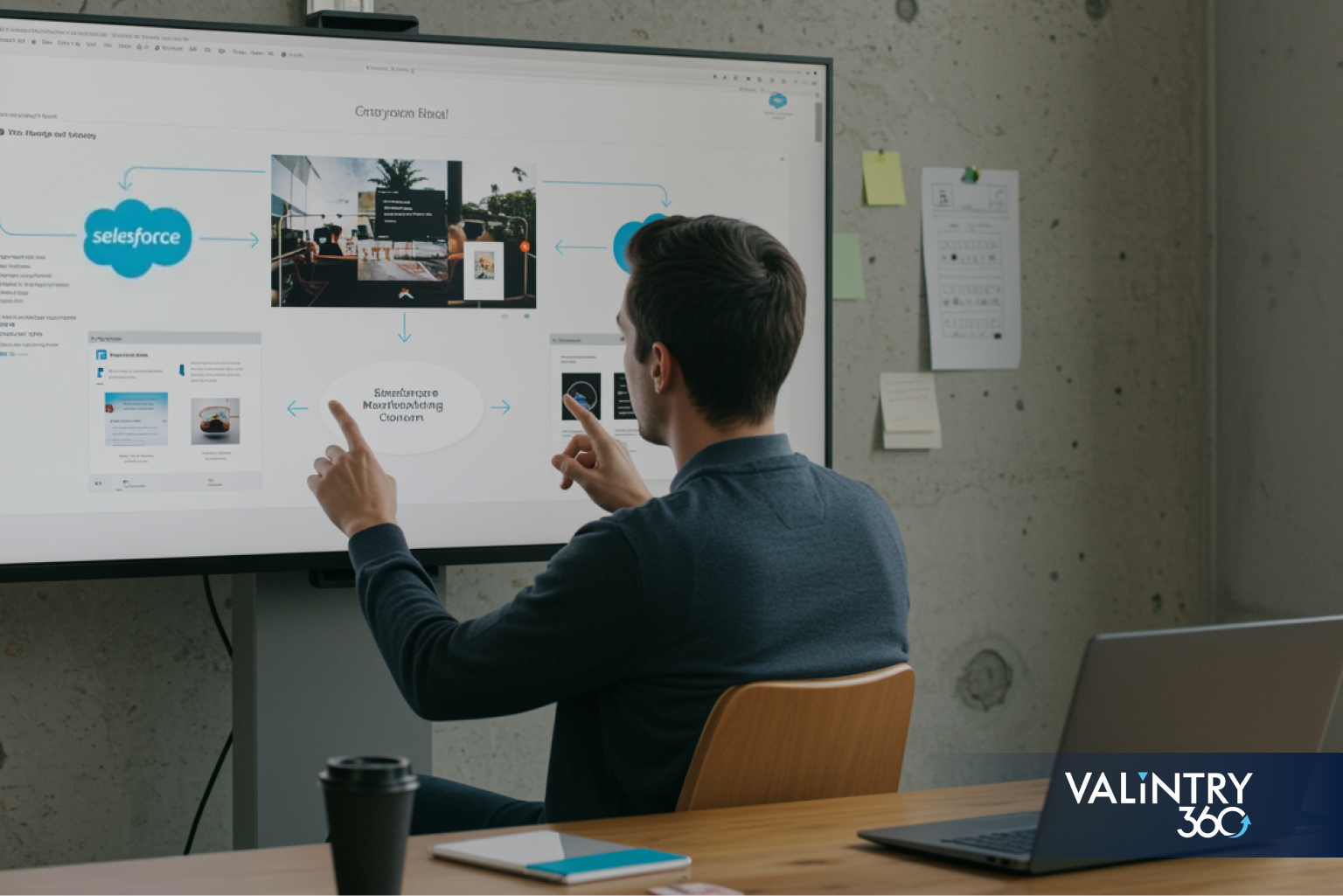
In 2025, the most successful marketing teams will be those that treat data architecture as a competitive advantage. As third-party cookies disappear and privacy laws evolve, enterprises are rethinking how to activate first-party data in real time.
At the heart of this transformation is Salesforce Marketing Cloud—spanning Engagement, Personalization (Interaction Studio), and Data Cloud—working together to create unified, privacy-safe personalization at scale.
Salesforce marketing automation consultant future-proof data model
A future-proof data model enables:
- Real-time personalization across email, web, app, and ads
- AI-driven decisions powered by clean, unified data
- Consent-aware activation for compliant personalization
- Higher ROI through more accurate segmentation
When done right, organizations see:
| Business Outcome | Measurable Impact |
|---|---|
| Better segmentation accuracy | +25% audience match rate |
| Improved personalization lift | +20–30% CTR and CVR gains |
| Faster activation | Minutes vs. hours |
| Lower compliance risk | 100% audit-ready consent traceability |
Architecture at a Glance
A Salesforce personalization ecosystem typically spans three layers:
- Marketing Cloud Engagement – Campaigns, journeys, triggered sends
- Marketing Cloud Personalization (Interaction Studio) – Real-time, on-site experience orchestration
- Salesforce Data Cloud – Unified identity, consent, and segmentation backbone
Architecture flow (described diagram):
CRM / Commerce / Service Data
│
▼
[Salesforce Data Cloud]
- Identity Resolution
- Unified Profile
- Consent Management
│
(Streaming + Batch Sync)
▼
[Marketing Cloud Engagement] ←→ [Marketing Cloud Personalization]
Journeys, Email/SMS Web/App Events, Real-Time Decisions
│
▼
Channels (Email, Web, Ads, SMS)
Identity spine: Data Cloud unifies customer records via durable IDs (CustomerID, ContactKey) and passes them downstream to Engagement and Personalization, enabling real-time, consent-aware activation.
Data Sources Inventory & Scoping
Don’t bring in every field—bring in data that drives personalization.
| Category | Example Sources | Purpose |
|---|---|---|
| CRM | Leads, Contacts, Accounts | Relationship, lifecycle segmentation |
| Commerce | Orders, Products, Wishlists | Abandonment, recommendations |
| Service | Cases, Feedback | Suppression and satisfaction models |
| Digital | Web & app events | Behavioral personalization |
| Ads | Clicks, conversions | Lookalike and suppression lists |
| Consent | Preferences, subscriptions | Governance and compliance |
Pro Tip: Prioritize the smallest dataset that supports your top three personalization use cases before scaling.
Identity Strategy
Identity stitching is where most personalization projects succeed—or fail.
Common Identifiers
- Contact Key – Primary key in Marketing Cloud Engagement
- Customer ID – Stable, durable cross-cloud identifier
- Email – Useful for communication, risky as a key (mutable)
- Anonymous ID – Cookies or device IDs, linked post-login
| Practice | Do | Don’t |
|---|---|---|
| Key Choice | Use ContactKey or CustomerID | Use email as a key |
| Hashing | Use SHA-256 hashed PII | Store plaintext |
| Merge Logic | Merge only deterministic matches | Auto-merge on names |
| Session Linking | Bridge anonymous → known user on login | Discard anonymous data early |
| Governance | Audit merges regularly | Allow silent overwrites |
Data Cloud Tip: Start with deterministic identity resolution (CRM ID, hashed email), and layer in probabilistic matching later for scale.
Consent, Privacy, and Governance

| Field | Description | Example Usage |
|---|---|---|
| OptInStatus | Marketing permission | Filter before send |
| PurposeCode | “Analytics,” “Personalization” | Purpose-based activation |
| Region | GDPR/CCPA tagging | Regional policy logic |
| LastUpdated | Consent timestamp | Audit readiness |
- Enforce consent before activation, not after.
- Align retention windows in Data Cloud with policy (e.g., 24 months).
- Create consent drift dashboards to detect CRM vs. Marketing mismatches.
Core Data Model Design (Engagement)
| Data Extension | Primary Key | Foreign Key | Key Fields | Purpose |
|---|---|---|---|---|
| Contacts | ContactKey | – | Name, Email, Segment | Master identity |
| Preferences | ContactKey | – | OptIn, Channel | Consent |
| Subscriptions | ContactKey | – | Topics, Date | Interest |
| Transactions | TransactionID | ContactKey | Amount, ProductID | Behavioral scoring |
| Events | EventID | ContactKey | Type, Timestamp | Trigger logic |
| Products | ProductID | – | Category, Price | Recommendations |
- Normalize reference tables (e.g., Products), denormalize behavioral data for performance.
- Establish primary/foreign key constraints for cleaner segmentation.
Core Data Model Design (Data Cloud)
| DMO | Description | Common Source |
|---|---|---|
| Individual | Unified profile | CRM Contact, Account |
| Engagement | Campaign, email activity | Marketing Cloud |
| Commerce | Orders, carts | Commerce Cloud or ERP |
| Event | Real-time behaviors | Web, app, POS |
| Consent | Preferences & flags | CRM or preference center |
- Map fields consistently from CRM to DMOs.
- Manage high-cardinality objects (Events, Transactions) carefully.
- Keep profiles under segmentation attribute limits (~2,000 per object).
Data Ingestion & Synchronization
| Method | Use Case | Latency | Guardrails |
|---|---|---|---|
| Synchronized Data Sources | CRM → Engagement | ~15 min | Avoid multi-level joins |
| Bulk Imports | Historical loads | Hours | Validate formats |
| Streaming API | Web/app events | Seconds | Enforce consent schema |
| Change Data Capture | CRM updates | Near real-time | Handle retry logic |
- ContactKey validated
- Consent flags synced
- Event timestamps accurate
- Audience counts QA’d before activation
Unified Customer Profile & Real-Time Events
Minimal Event Schema Example:
| Field | Required | Description |
|---|---|---|
| EventID | Yes | Unique key |
| ContactKey | Yes | Profile link |
| EventType | Yes | “PageView,” “AddToCart” |
| Timestamp | Yes | Event time |
| ProductID | Optional | Contextual data |
| Value | Optional | Transaction amount |
Goal: Capture behaviors in real time, stitch to unified profiles, and activate within seconds through Marketing Cloud Personalization.
Segmentation Strategy
- Engagement: SQL- or filter-based, batch audience creation.
- Data Cloud: Real-time, AI-assisted segmentation at enterprise scale.
- Index high-use fields (ContactKey, Segment).
- Keep joins ≤ 3 for performance.
- Create reusable segment templates like “Active Buyers” or “High Intent Visitors.”
Journey Orchestration & Triggers
Modern journeys trigger from real-time data, not static lists.
| Trigger Type | Example | Channel |
|---|---|---|
| Transactional | Purchase or renewal | |
| Behavioral | Browse abandon, download | SMS / Web |
| Predictive | Propensity threshold crossed | Multi-channel |
Add suppression and frequency caps to prevent fatigue.
Channel-Level Personalization Patterns
| Channel | Data Inputs | Example Use Case |
|---|---|---|
| Email / SMS | Profile + Event data | Personalized promotions |
| Web / App | Real-time events | Product banners, offers |
| Ads | Unified segments | Lookalike expansion, buyer suppression |
AI Assist & Propensity Modeling

- RFM metrics
- Product affinity scores
- Event velocity indicators
Data Quality & Observability
- Running deduplication scorecards (by ContactKey & hashed email)
- Monitoring missingness dashboards for key attributes
- Using test datasets for QA before activation
- Performing monthly backfills for gold records
Performance, Limits, and Cost Controls
- Query window ≤ 30 minutes
- < 100 attributes per Data Extension
- Archive inactive segments quarterly
- Monitor Data Cloud compute usage via usage dashboards
Measurement Framework
| Metric | Baseline | Personalized | Lift |
|---|---|---|---|
| Click-Through Rate (CTR) | 2.4% | 3.1% | +29% |
| Conversion Rate (CVR) | 1.2% | 1.6% | +33% |
| Average Order Value (AOV) | $85 | $98 | +15% |
Simple ROI Formula:
ROI = (Audience × Baseline CVR × Uplift % × AOV) – Activation Cost
Case Scenarios
B2B: Account-Based Nurture
Before: Static lead nurturing with 2% engagement.
After: Unified CRM and web behavior data enable role-based web personalization → 5.5% CTR, 3× faster pipeline velocity.
B2C: Browse-Abandon + Back-in-Stock
Before: Daily batch emails.
After: Real-time product event sync → triggered within 5 minutes → +22% conversion rate.
Risk & Mitigation Table
| Risk | Description | Mitigation |
|---|---|---|
| Email used as key | Breaks joins if changed | Use ContactKey / CustomerID |
| Late data arrival | Missed journeys | Buffer + retry logic |
| Consent drift | CRM vs. Marketing mismatch | Centralize consent sync |
| Over-segmentation | Audience dilution | Focus on high-value segments |
| Cost creep | Attribute bloat | Quarterly cleanup audits |
30/60/90-Day Implementation Roadmap
| Phase | Focus | Deliverables |
|---|---|---|
| 30 Days (Crawl) | Data audit & identity plan | Source inventory, key design |
| 60 Days (Walk) | Data model build | Data extensions, mappings live |
| 90 Days (Run) | Activation & measurement | Journeys launched, KPIs tracked |
10-Point Implementation Checklist
- Define durable ID (ContactKey/CustomerID)
- Audit consent and privacy data
- Map fields to DMOs
- Configure Data Designer links
- Sync CRM & commerce data
- Enable streaming events
- Validate unified profile view
- QA segment accuracy
- Launch pilot journeys
- Benchmark personalization lift
Security & Compliance Essentials
- Align retention windows to regulation (GDPR/CCPA)
- Support deletion and DSAR workflows via APIs
- Maintain an incident response plan integrated with Salesforce Shield
Conclusion: The Next Step in Salesforce Personalization
A scalable, compliant data model is the foundation of every successful personalization program. It enables real-time engagement, predictive intelligence, and measurable ROI—while safeguarding customer trust.
For mid-market and enterprise teams looking to modernize their Salesforce stack, VALiNTRY360’s Marketing Automation Consulting practice helps design and implement data models that connect CRM, Marketing Cloud, and Data Cloud for true personalization at scale.
Ready to future-proof your Salesforce personalization strategy?
Contact VALiNTRY360’s Marketing Automation Consulting team to start your data model assessment.
Related Posts
How Salesforce Data Cloud Evolves into Data 360…
Nearly 80% of enterprise data remains unstructured, and many organizations still find it difficult to access, organize, and extract useful insights from it. This ongoing challenge is exactly what Data 360 is built to solve through its latest phase of…
Sales Engagement in Salesforce: Cadences, Queues & Analytics
B2B selling pipeline velocity depends less on volume and more on precision. Sales Engagement in Salesforce helps revenue teams achieve that precision by combining three powerful pillars: cadences, work queues, and sales analytics. Together, these tools streamline outreach, strengthen rep…
How Marketing Automation Consulting Drives Always-On Salesforce Success
With a daily tech-evolving market now buyers research 24/7 across multiple channels. For mid-market and enterprise teams, that means campaigns must always be “on”—adapting to behavior, intent, and lifecycle stage in real time. Yet, many marketing teams still rely on…

